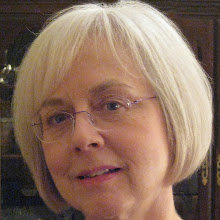I am pleased to have been quoted in the Art New England February-March 2010 issue on page 20 in an article titled "Innovative Printmaking" by Andre van der Wende. It is an informative article about new methods and materials in printmaking, with a large focus on digital printmaking. The author lays out the issues clearly and articulates the various positions that can be taken on them. http://www.artnewengland.com/
Here is the full text of my response to his email interview:
1. When did you first start making digital prints? and do you still make prints using traditional methods?
I started experimenting with digital drawing in 1992 using Painter software and a Wacom digitizing tablet and stylus. In the beginning I used it for prototyping ideas for paintings, but in 1997 I published my first digital print, "Marigold."
Since you can do anything digitally that you can do with traditional media, plus a great deal more, I no longer use traditional media.
2. By making digital prints what do you feel you are both gaining and losing by trading in traditional methods for digital?
The most important feature I gain by working digitally is the ability to use layers, which can be conceived of as transparent drawing sheets stacked on top of each other. The artist can put lines on one layer and tones on another and then can change one without affecting the other. To create negative space, you can simply draw with white on top of dark. Layers also offer the artist much more control; you can make subtle adjustments to the opacity of a layer, to it's position, and to it's color. By turning a layer on and off you can see whether a change is an improvement or not, which facilitates experimentation. Once the drawing is finished, you collapse all the layers onto the canvas, or bottom layer.
Other advantages of digital drawing over traditional are the ability to "undo," to use a reference photo on a layer in lieu of time-consuming cartooning (I work in a photorealist style), to combine multiple paper textures and multiple drawing tools in one image, to have brushes in infinite sizes, and to be able to save stages and variations of the image as you draw. From a marketing point of view, digital drawing combines the creative freedom of unique work with advantages of multiples (prints), so that the artist can both keep a complete portfolio of his or her own art for artistic reference and promotion, while reaching wider audience at the same time. Creating digitally can obviate the need for expensive photographic documentation, and jpegs are far easier to work with than traditional slides. On a purely pragmatic level, you are free of dirt and toxic fumes; there is no heavy lifting; and cleaning up the studio consists of hitting the "Off" button.
The only thing I lose by working digitally is that, because it is a new medium, people are slow to recognize it as a valid medium.
3. What has your experience been in terms of people being more open or more reticent toward digital technology and digital prints?
It is finally becoming more acceptable to work digitally. People, oddly, have had no problem regarding their digital bank accounts as real, but there has been enormous resistance to digital prints on the grounds that somehow they are not "real," this, even though they consist of pigment on paper caused to be there by the artist's hand, just as with traditional media.
Another obstacle to the recognition of digital art is the giclee, an ink jet reproduction of an artwork done in another medium. Many people assume that all ink jet prints are giclees, which is not the case.
4. Does digital technology further blur the distinction between printmaking and photography?
In the hands of serious artists, rather than blurring a distinction, I think digital technology creates new options for combining printmaking and photography.
An illegitimate (in my opinion) blurring of the two media is the practice of running a photograph through a Photoshop filter or using an auto-paint brush, where the finished art is actually made by the computer, not the artist.
5. Given that traditional printmaking techniques are often labor intensive, is the relative freedom of digital techniques liberating?
You must be joking! Working digitally is actually more difficult in many ways. You have computers and printers to maintain, software to learn and keep up with, the retraining of hand and eye to work on a tablet while seeing the results on a monitor, not to mention the difficulty of zoom levels to overcome. If you are zoomed in enough to see what you are doing, you are too far in to see the overall effect. If you are zoomed out to view the whole image, you can't see what you are drawing. In the end, my digital drawings end up taking slightly longer than my ones in traditional media used to, but I feel compensated by the advantages I cited above.
6. Within New England, who are some other printmakers you consider innovative and forward thinking?
Deborah Cornell, head of the Printmaking Department at BU
============================================
Links:
DIGITAL ART: Martha Jane Bradford
Web Site: http://www.marthavista.com/
LinkedIn: http://www.linkedin.com/
search "Martha Jane Bradford"
MJB Blog: http://marthajanebradford.blogspot.com/
VIRTUAL ART: Alizarin Goldflake
Second Life avatar of Martha Jane Bradford
Atelier Alizarin (Second Life studio): http://slurl.com/secondlife/Lie/222/189/35
Blog: http://alizaringoldflake.blogspot.com/
Flickr: http://www.flickr.com/photos/alizaringoldflake/
YOUTUBE VIDEOS:
Acquarella: http://www.youtube.com/watch?v=u-lo6JosN0M
Anza-Borrego Oak: http://www.youtube.com/watch?v=5s_KRMi55v8
Metempsyche's Garden: http://www.youtube.com/watch?v=GfQGuNXWvLo
The Maze: http://www.youtube.com/watch?v=OEa9rtEiINE
Atelier Alizarin Studio Tour: http://www.youtube.com/watch?v=XDjrLmPpopA
The Mysterious Forest: http://www.youtube.com/watch?v=c6Xv_pAf0Qc
Museum of Science Project Concept: http://www.youtube.com/watch?v=93YYMJANpZs
Subscribe to:
Post Comments (Atom)

No comments:
Post a Comment